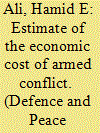| Srl | Item |
| 1 |
ID:
124518


|
|
|
|
|
| Publication |
2013.
|
| Summary/Abstract |
There has been much debate in many forums to seek a settlement of the Darfur conflict (DC), but no study has addressed its economic cost. This study is the first attempt to quantify the economic cost of the DC. The war's costs include the destruction of infrastructure, direct military spending attributable to the war effort, and the impact of the latter on capital formation. In addition, the human destruction - loss of life and income - must be taken into account. Our calculations show that the government of Sudan has incurred costs totaling US$30.5 billion, equivalent to 171% of 2003 Gross Domestic Product GDP, on the war in Darfur. This includes $10.1 billion in direct military expenses; $7.2 billion in the lost productivity of internally displaces persons; $2.6 billion in foregone lifetime earnings of the dead; $4.1 billion in infrastructure damage; and $6.5 billion in war impacts on GDP. The total costs of the war are $41.5 billion if we added military spillover and African Union/UN hybrid operation in Darfur peace-keeping operations of $10.9 billion. While the country has spent only 1.3% of its budget on public health and less than 1% on education over the past two decades. The war consumes 13% of GDP in a society that lacks the means to provide the basic entitlements of education, food, health care, and shelter to its people.
|
|
|
|
|
|
|
|
|
|
|
|
|
|
|
|
| 2 |
ID:
128306


|
|
|
|
|
| Publication |
2014.
|
| Summary/Abstract |
This study examines the relationships among economic growth, domestic investment, real exchange rate and trade openness in Indonesia using the Johansen cointegration test and Granger causality test. The results suggest that there exists a long-run relationship among the variables. All the estimated coefficients of the long-run equation have the correct positive signs and significant at least at the 5 per cent level. Specifically, in the long run, a 1 per cent increase in trade openness leads to about 26.5 per cent increase in Indonesian real GDP, a 1 per cent increase in domestic investment will spur real GDP by 1.8 per cent, and a 1 per cent depreciation of the rupiah raises real GDP by about 6.4 per cent. The results from the Granger causality test suggest that all the variables affect real GDP in the short run. Both trade openness and gross domestic investment cause growth unidirectionally in the short run, but feedback occurs between growth and the real exchange rate. The evidences suggest that trade openness, gross domestic investment and the exchange rate are important determinants of economic growth and therefore policy makers should seriously take these variables into account in their policy construct in order to achieve sustained economic growth in Indonesia. Specifically, Indonesia should liberalise foreign trade, improve the domestic investment climate and maintain exchange rate stability.
|
|
|
|
|
|
|
|
|
|
|
|
|
|
|
|